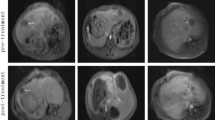Abstract
Introduction
The purpose of this study was to observe sequential changes in rabbit VX2 liver tumors using transmission electron microscopy after high-intensity focused ultrasound (HIFU) ablation enhanced with the contrast agent SonoVuer® (Bracco, Milan, Italy).
Methods
Thirty New Zealand rabbits with VX2 liver tumors were randomly divided into two groups. The liver tumors of rabbits in Group A underwent single HIFU ablation; those in Group B were given the ultrasound contrast agent SonoVue 0.2 mL/kg before HIFU exposure. Five rabbits from each of the two groups were killed at 0 hours, 6 days, and 14 days after HIFU ablation. Tissue samples that included targeted and untargeted tissue were observed using transmission electron microscopy.
Results
Using transmission electron microscopy, it was evident that most of the cellular organs in the targeted areas of tumors in Groups A and B had disappeared early after HIFU, but the basic cell structure was seen in Group A. On the sixth day after HIFU ablation, all cells in the targeted areas were disrupted, and fibrous bands were detected in the rims of targeted areas in both groups. In the surrounding areas, cell swelling in Group B was more severe than in Group A, and a greater number of apoptotic bodies were found in Group B.
Conclusion
The use of an ultrasound contrast agent can enhance the effects of HIFU ablation on the destruction of cell ultrastructure and can enlarge the region of HIFU ablation; this provides experimental evidence for the use of contrast agents in controlling the effects of HIFU.
Similar content being viewed by others
References
Colombel M, Gelet A. Principles and results of high-intensity focused ultrasound for localized prostate cancer. Prostate Cancer Prostatic Dis. 2004;7:289–294.
Harvey CJ, Pilcher JM, Eckersley RJ, Blomley MJ, Cosgrove DO. Advances in ultrasound. Clin Radiol. 2002;57:157–177.
Brujan EA, Ikeda T, Matsumoto Y. Jet formation and shock wave emission during collapse of ultrasound-induced cavitation bubbles and their role in the therapeutic applications of high-intensity focused ultrasound. Phys Med Biol. 2005;50:4797–4809.
ter Haar G. Therapeutic ultrasound. Eur J Ultrasound. 1999;9:3–9.
Taihei I, Takehide A, Osamu K, Katsuhiko F, Hiroshi H, Takenori OT. Histological classification of rabbit liver treated with high-intensity focused ultrasound: application of the new HIFU using phased array method. Int Congr Ser. 2004;1274:175–183.
Kennedy JE, Wu F, ter Haar GR, et al. High-intensity focused ultrasound for the treatment of liver tumors. Ultrasonics. 2004;42:931–935.
Yu T, Xiong S, Mason TJ, Wang Z, The use of a micro-bubble agent to enhance rabbit liver destruction using high-intensity focused ultrasound. Ultrason Sonochem. 2006;13:143–149.
Illing RO, Kennedy JE, Wu F, et al. The safety and feasibility of extracorporeal high-intensity focused ultrasound (HIFU) for the treatment of liver and kidney tumours in a Western population. Br J Cancer. 2005;93:890–895.
Gelet A, Chapelon JY, Poissonnier L, et al. Local recurrence of prostate cancer after external beam radiotherapy: early experience of salvage therapy using high-intensity focused ultrasonography. Urology. 2004;63:625–629.
Chan AH, Fujimoto VY, Moore DE, Held RT, Paun M, Vaezy S. In vivo feasibility of image-guided transvaginal focused ultrasound therapy for the treatment of intracavitary fibroids. Fertil Steril. 2004;82:723–730.
Wang GM, Yang YF, Sun LA, Xu ZB, Xu YQ. An experimental study on high-intensity focused ultrasound combined with mitomycin treatment of bladder tumor. Zhonghua Wai Ke Za Zhi. 2003;41:897–900.
Wu F, Wang ZB, Chen WZ, et al. Extracorporeal focused ultrasound surgery for treatment of human solid carcinomas: early Chinese clinical experience. Ultrasound Med Biol. 2004;30:245–260.
Gelet A, Chapelon JY, Bouvier R, Pangaud C, Lasne Y. Local control of prostate cancer by transrectal high intensity focused ultrasound therapy: preliminary results. J Urol. 1999;161:156–162.
Yu T, Fan X, Xiong S, Hu K, Wang Z. Microbubbles assist goat liver ablation by high intensity focused ultrasound. Eur Radiol. 2006;16:1557–1563.
Tung YS, Liu HL, Wu CC, Ju KC, Chen WS, Lin WL. Contrast-agent-enhanced ultrasound thermal ablation. Ultrasound Med Biol. 2006;32:1103–1110.
Kaneko Y, Maruyama T, Takegami K, et al. Use of a microbubble agent to increase the effects of high intensity focused ultrasound on liver tissue. Eur Radiol. 2005;15:1415–1420.
Wu F, Wang ZB, Cao YD, et al. Heat fixation of cancer cells ablated with high-intensity-focused ultrasound in patients with breast cancer. Am J Surg. 2006;92:179–184.
Haar GT, Coussios C. High intensity focused ultrasound: physical principles and devices. Int J Hyperthermia. 2007;23:89–104.
Rabkin BA, Zderic V, Vaezy S. Hyperecho in ultrasound images of HIFU therapy: involvement of cavitation. Ultrasound Med Biol. 2005;31:947–956.
Feng F, Mal A, Kabo M, et al. The mechanical and thermal effects of focused ultrasound in a model biological material. J Acoust Soc Am. 2005;117:2347–2355.
Saga Y, Tamiaki H. Transmission electron microscopic study on supramolecular nanostructures of bacteriochlorophyll self-aggregates in chlorosomes of green photosynthetic bacteria. J Biosci Bioeng. 2006;102:118–123.
Zheng LD, Tong QS, Wu CH. Growth inhibition and apoptosis inducing mechanisms of curcumin on human ovarian cancer cell line A2780. Chin J Integr Med. 2006;12:126–131.
Xie ZJ, Jia LM, He YC, Gao JT, Morphological observation of tumor infiltrating immunocytes in human rectal cancer. World J Gastroenterol. 2006;12:1757–1760.
Clemens MG, McDonagh PF, Chaudry IH, Baue AE, Hepatic microcirculatory failure after ischemia and reperfusion: improvement with ATP-MgCl2 treatment. Am J Physiol. 1985;248:H804–H811.
Zamzami N, Hirsch T, Dallaporta B, Petit PX, Kroemer G. Mitochondrial implication in accidental and programmed cell death: apoptosis and necrosis. J Bioenerg Biomembr. 1997;29:185–193.
Holt RG, Roy RA. Measurements of bubble-enhanced heating from focused, MHz-frequency ultrasound in a tissue-mimicking material. Ultrasound Med Biol 2001;7:1399–1412.
Author information
Authors and Affiliations
Corresponding author
Additional information
Qiuyang Li and Junfeng Du contributed equally to this paper.
Rights and permissions
About this article
Cite this article
Li, Q., Du, J., Yu, M. et al. Transmission electron microscopy of VX2 liver tumors after high-intensity focused ultrasound ablation enhanced with SonoVue®. Adv Therapy 26, 117–125 (2009). https://doi.org/10.1007/s12325-008-0126-7
Received:
Published:
Issue Date:
DOI: https://doi.org/10.1007/s12325-008-0126-7




